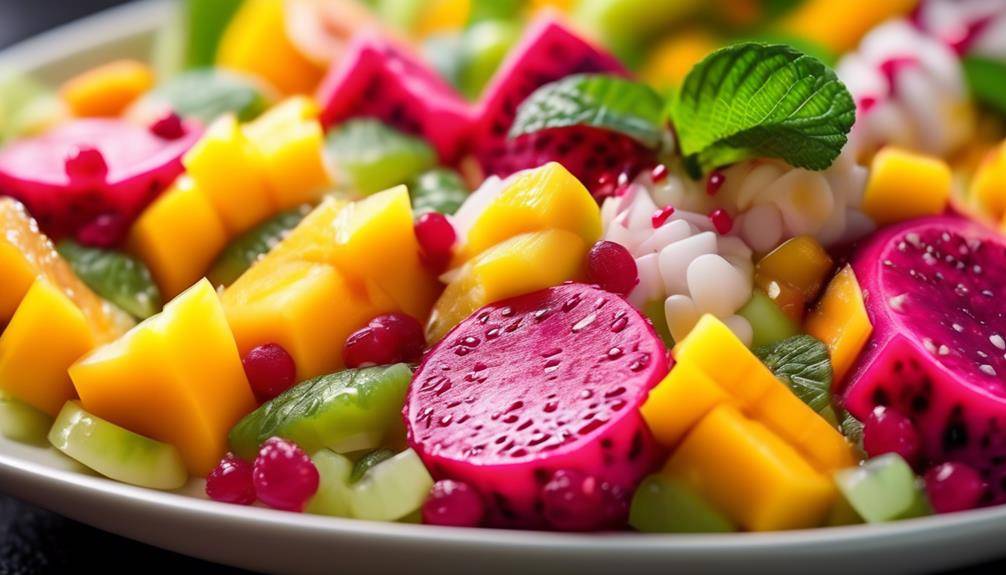The Best Thai Food For Diabetics

The Best Thai Food For Diabetics; Are you a diabetic looking for delicious and satisfying meal options that won’t compromise your health? Look no further than Thai cuisine. With its bold flavors and vibrant ingredients, Thai food can be a great choice for those managing diabetes. But how can you enjoy the flavors of Thailand without worrying about your blood sugar levels? In this discussion, we will explore the key ingredients, cooking techniques, and flavorful dishes that make Thai cuisine a diabetic-friendly option. Stay tuned to discover how you can indulge in the rich flavors of Thai food while keeping your diabetes in check.
Understanding Thai Cuisine and Diabetes
To better manage your diabetes while enjoying Thai cuisine, it is important to understand the impact of various ingredients and cooking techniques on your blood sugar levels. Thai cuisine is known for its bold flavors and aromatic herbs, but it can also be high in carbohydrates and sugar, which can affect your blood sugar control. However, with some knowledge and careful choices, you can still enjoy Thai food without compromising your health.
One key aspect to consider when managing your blood sugar levels is the use of Thai herbs in cooking. Thai cuisine is rich in herbs like lemongrass, basil, and coriander, which not only add flavor but also have potential health benefits for diabetics. For example, studies have shown that certain Thai herbs, such as holy basil, may have hypoglycemic effects, meaning they can help lower blood sugar levels. Incorporating these herbs into your meals can not only enhance the taste but also contribute to better blood sugar management.
In addition to herbs, it is important to be mindful of the ingredients used in Thai cooking. Traditional Thai dishes often contain rice or noodles, which can cause a rapid rise in blood sugar levels. Opting for whole grain rice or choosing dishes that use vegetables or lean proteins as a base can help mitigate this effect. Additionally, be cautious of dishes that are deep-fried or heavily sauced, as they may contain hidden sugars or unhealthy fats.
When dining out at a Thai restaurant, it is also helpful to communicate with the chef or server about your dietary needs. They may be able to suggest diabetic-friendly options or make adjustments to dishes to accommodate your requirements.
Key Ingredients for Diabetic-Friendly Thai Meals
When it comes to preparing diabetic-friendly Thai meals, it’s important to consider sugar alternatives that won’t spike your blood sugar levels. Look for low-carb protein sources like lean meats, tofu, or seafood to add a healthy dose of protein to your dishes. Additionally, practicing healthy cooking techniques such as grilling, steaming, or stir-frying can help minimize the use of unhealthy fats and oils.
Sugar Alternatives in Thai Cuisine
Thai cuisine offers a wide range of sugar alternatives, making it easy for diabetics to enjoy flavorful and diabetic-friendly meals. When it comes to beverages, there are several options that can satisfy your thirst without causing a spike in your blood sugar levels. Here are some diabetic-friendly beverages commonly found in Thai cuisine:
- Herbal Teas: Thai herbal teas like lemongrass, butterfly pea flower, and pandan are naturally sweet and refreshing, without the need for added sugars.
- Coconut Water: Known for its natural sweetness and hydrating properties, coconut water is a great choice for those looking for a low-sugar beverage.
- Fresh Fruit Juices: Thai cuisine is known for its abundance of tropical fruits. Enjoy a glass of freshly squeezed juice from fruits like guava, pineapple, or watermelon for a naturally sweet and nutritious treat.
Low-Carb Protein Sources
With a focus on creating diabetic-friendly Thai meals, it is essential to explore low-carb protein sources that can elevate the nutritional value of your dishes. Incorporating low-carb vegetarian options into your meals not only helps to control blood sugar levels but also provides numerous health benefits for diabetics. By choosing vegetarian sources of protein such as tofu, tempeh, and seitan, you can enjoy delicious Thai dishes without worrying about excessive carbohydrates. These protein-rich ingredients not only help to keep you feeling full for longer but also support muscle growth and repair.
Additionally, low-carb diets have been shown to improve insulin sensitivity, promote weight loss, and reduce the risk of heart disease in individuals with diabetes. So, whether you’re a vegetarian or simply looking to incorporate more plant-based proteins into your diet, low-carb options are a great choice to enhance the nutritional value of your diabetic-friendly Thai meals.
Healthy Cooking Techniques
To create diabetic-friendly Thai meals, incorporating healthy cooking techniques and key ingredients is essential. Here are some healthy grilling techniques and low-fat cooking methods that can help you prepare delicious and diabetes-friendly Thai dishes:
- Grilling: Grilling your meat, seafood, or vegetables is a great way to add flavor without adding extra fat. Marinate your protein with a mixture of herbs, spices, and citrus juices to enhance the taste.
- Steaming: Steaming is a low-fat cooking method that preserves the nutrients in your ingredients. Use a bamboo steamer or a steaming basket to cook your vegetables, seafood, or tofu until tender and flavorful.
- Stir-Frying: Stir-frying with minimal oil is another healthy cooking technique. Use a non-stick pan or wok and quickly cook your ingredients over high heat to retain their natural flavors and textures.
Spice up Your Diabetic Diet With Thai Soups
Looking to add some variety to your diabetic diet? Thai soups can be a delicious and healthy option. Not only are they packed with flavor, but they also offer numerous benefits for managing diabetes. From Tom Yum to Tom Kha Gai, there are plenty of diabetic-friendly soup recipes to choose from. Plus, with a few tips on portion control and ingredient substitutions, you can easily incorporate Thai soups into your regular meal plan.
Benefits of Thai Soups
Thai soups offer a flavorful and nutritious addition to your diabetic diet, providing numerous benefits for managing your blood sugar levels effectively. Incorporating Thai soups into your meals can be a smart choice to spice up your diabetic diet. Here are some reasons why Thai soups are beneficial for diabetics:
- Low Glycemic Index: Thai soups are typically made with ingredients that have a low glycemic index, meaning they have a minimal impact on your blood sugar levels.
- High in Fiber: Many Thai soups are packed with vegetables and herbs, which are rich in fiber. Fiber helps slow down the absorption of sugar into the bloodstream, keeping your blood sugar levels stable.
- Balanced Flavors: Thai soups are known for their combination of sweet, sour, salty, and spicy flavors. This balance of flavors can satisfy your taste buds and help curb cravings for unhealthy snacks.
To incorporate Thai soups into your diet, opt for clear broth-based soups rather than creamy ones. Additionally, choose soups with lean protein sources, such as chicken or shrimp, and load up on fresh vegetables. Remember to monitor portion sizes and pair your soup with whole grains or protein for a well-balanced meal.
Diabetic-Friendly Soup Recipes
Enhance your diabetic diet with delicious and nutritious Thai soup recipes that are specifically tailored to meet your dietary needs. Thai cuisine offers a variety of diabetic-friendly soup options that are packed with flavor and low in sugar and carbohydrates. These soups can be enjoyed as appetizers or side dishes to complement your main course.
One popular diabetic-friendly Thai soup is Tom Yum Soup, which is made with a flavorful broth, shrimp or chicken, and a mix of herbs and spices. This soup is not only delicious but also provides essential nutrients like vitamins and minerals. Another option is the Tom Kha Gai Soup, which is a creamy coconut soup with chicken and fragrant herbs.
When preparing these soups, it’s important to use fresh ingredients and choose lean proteins. You can also add extra vegetables like mushrooms, bell peppers, and spinach to increase the nutritional value. Additionally, be mindful of the amount of sodium used in the soup and opt for low-sodium broth or seasonings whenever possible.
Tips for Incorporating Thai Soups Into Your Diet
Are you ready to add some delicious and nutritious Thai soups to your diabetic diet? Thai cuisine offers a wide variety of flavorful soups that can be a great addition to your meal plan. Here are some tips to help you incorporate Thai soups into your diet:
- Look for low sodium alternatives: Thai soups often contain fish sauce or soy sauce, which can be high in sodium. Opt for low sodium options or use reduced sodium versions of these ingredients to control your sodium intake.
- Practice portion control: While Thai soups can be packed with healthy ingredients, it’s important to watch your portion sizes. Stick to a small bowl or cup and pair it with a balanced meal to ensure you’re getting the right amount of nutrients.
- Load up on vegetables: Thai soups are typically loaded with vegetables, which are high in fiber and low in calories. Fill your soup with a variety of colorful veggies to boost the nutritional value.
Exploring Healthy Thai Salad Options for Diabetics
To make healthier choices for your diet, consider exploring a variety of nutritious Thai salad options that are suitable for individuals with diabetes. Thai cuisine offers a wide range of salads that can be both flavorful and diabetes-friendly. When it comes to Thai salads, it’s important to pay attention to the dressings and ingredients used, as they can greatly affect the overall nutritional value of the dish.
When selecting dressings for your Thai salad, opt for healthier options such as lime juice, fish sauce, or vinegar. These dressings are low in added sugars and can add a tangy and refreshing flavor to your salad. Avoid dressings that are high in sugar or contain unhealthy fats, such as creamy or sweet dressings.
When balancing flavors in Thai salads, it’s important to incorporate a variety of ingredients. Start with a base of fresh vegetables like lettuce, cucumber, and bell peppers. These vegetables provide essential nutrients and fiber while adding crunch to your salad. You can then add protein options such as grilled chicken, shrimp, or tofu for a satisfying and filling meal. Don’t forget to include herbs like cilantro, mint, and Thai basil, as they can enhance the flavor profile of your salad.
To add an extra kick to your Thai salad, consider incorporating spicy ingredients like chili peppers or Thai chili sauce. These ingredients can help boost your metabolism and add a flavorful punch to your dish. However, be mindful of your tolerance to spice and adjust accordingly.
Navigating Diabetic-Friendly Thai Curries
As you continue to explore healthy options in Thai cuisine for individuals with diabetes, let’s now focus on navigating diabetic-friendly Thai curries. Thai curries are known for their bold flavors and aromatic spices, but they can also be a great option for managing blood sugar levels. By making a few modifications and choosing the right ingredients, you can enjoy delicious and diabetic-friendly Thai curry recipes without compromising your health.
Here are three key tips for creating diabetic-friendly Thai curries:
- Choose lean proteins: Opt for lean proteins like skinless chicken breast, shrimp, or tofu in your curry. These proteins are lower in fat and can help stabilize blood sugar levels. Be mindful of the portion size and avoid deep-fried proteins, which can increase the fat and calorie content of the dish.
- Load up on vegetables: Adding a variety of vegetables to your curry not only enhances the flavor but also provides essential nutrients and fiber. Choose low-carbohydrate options like broccoli, bell peppers, mushrooms, and spinach. These vegetables have a low glycemic index, meaning they have a minimal impact on blood sugar levels.
- Use homemade curry pastes: Many store-bought curry pastes contain added sugars and unhealthy fats. To keep your curry diabetic-friendly, make your own curry paste using fresh ingredients like lemongrass, ginger, garlic, and spices. This way, you can control the amount of sugar and fat in your curry.
Satisfying Your Cravings With Diabetic-Friendly Thai Stir-Fries
Satisfy your cravings for flavorful, diabetic-friendly meals with Thai stir-fries that are packed with nutritious ingredients and bursting with authentic flavors. Thai cuisine offers a wide variety of stir-fry options that can be easily modified to suit a diabetic-friendly diet. By incorporating fresh vegetables, lean proteins, and flavorful seasonings, you can create delicious and healthy stir-fries that will leave you feeling satisfied.
When it comes to choosing ingredients for your diabetic-friendly Thai stir-fries, opt for low-carb vegetables such as broccoli, bell peppers, mushrooms, and bok choy. These vegetables are high in fiber and essential nutrients while being low in carbohydrates, making them ideal for managing blood sugar levels. Additionally, include lean proteins like chicken, shrimp, or tofu to add satiety and balance to your meal.
To enhance the flavors of your stir-fries, use diabetic-friendly sauces like soy sauce, fish sauce, or chili paste. These condiments provide a burst of flavor without adding excessive sugar or calories. Remember to use them in moderation and be mindful of their sodium content if you have high blood pressure.
Pair your diabetic-friendly Thai stir-fries with some healthy drink options. Instead of sugary beverages, opt for unsweetened iced tea or infused water with a squeeze of lime or lemon. These options are refreshing, hydrating, and won’t cause a spike in your blood sugar levels.
Discovering Low-Carb Thai Noodle Dishes for Diabetics
Are you looking for low-carb Thai noodle dishes that are suitable for diabetics? Look no further! Thai cuisine is known for its rich flavors and vibrant ingredients, and there are plenty of options for those who are watching their carb intake. Here are some delicious low-carb Thai noodle dishes that you can enjoy without worrying about your blood sugar levels:
- Zucchini Pad Thai: Replace traditional rice noodles with zucchini noodles to create a low-carb version of this classic dish. Zucchini noodles are packed with nutrients and have a similar texture to rice noodles, making them a perfect substitute.
- Shirataki Noodle Soup: Shirataki noodles, made from the konjac plant, are extremely low in carbs and calories. They can be used in a variety of Thai noodle soups, such as Tom Yum or Tom Kha, for a satisfying and diabetic-friendly meal.
- Spicy Thai Beef Salad with Bean Sprouts: This salad is a great option for those looking for a low-carb Thai dish. It combines thinly sliced beef, fresh herbs, and bean sprouts, all tossed in a spicy dressing. It’s a flavorful and filling meal that won’t spike your blood sugar.
When it comes to Thai cuisine, it’s important to be mindful of the ingredients used in the dishes. While traditional Thai desserts may not be suitable for diabetics due to their high sugar content, there are alternatives available. Look for low-carb Thai desserts that use natural sweeteners like stevia or monk fruit, and opt for small portions to keep your blood sugar in check.
In addition to noodle dishes, there are also diabetic-friendly Thai curry alternatives. Instead of using high-carb ingredients like potatoes or jasmine rice, consider using cauliflower rice or adding extra vegetables to your curry. This will help reduce the overall carb content while still enjoying the rich flavors of Thai curry.
Enjoying Diabetic-Friendly Thai Seafood Delights
Indulge in a variety of flavorful and diabetic-friendly Thai seafood dishes. Thai cuisine is known for its bold flavors and the use of fresh ingredients, making it an excellent choice for individuals with diabetes. When it comes to diabetic-friendly Thai seafood appetizers, there are plenty of options to satisfy your cravings while keeping your blood sugar levels in check.
One key aspect of managing diabetes is controlling portion sizes. This holds true when enjoying Thai seafood dishes as well. It’s important to be mindful of the amount of food you consume to maintain stable blood sugar levels. Opt for smaller portions and avoid overindulging, even if the dish is labeled as diabetic-friendly.
When choosing diabetic-friendly Thai seafood appetizers, look for dishes that are grilled, steamed, or stir-fried. These cooking methods help to retain the natural flavors of the seafood without adding excessive fats or sugars. Some popular options include grilled fish with herbs, steamed shrimp with spicy lime dressing, and stir-fried squid with vegetables.
Another important consideration when enjoying Thai seafood dishes is the sauce. Many Thai sauces can be high in sugar and calories, so it’s best to choose sauces that are lighter and lower in sugar content. Opt for dishes with sauces that are made from ingredients like lime juice, fish sauce, and herbs, as these tend to be lower in sugar and still pack a flavorful punch.
Indulging in Diabetic-Friendly Thai Desserts
To enjoy diabetic-friendly Thai desserts, opt for options that are low in sugar and incorporate fresh fruits and herbs. Thai cuisine offers a variety of delectable desserts that can be enjoyed by individuals with diabetes without compromising their health. Here are some delicious and guilt-free options for you to indulge in:
- Mango with Sticky Rice: This classic Thai dessert combines the sweetness of ripe mangoes with the creaminess of coconut-infused sticky rice. It is a delightful treat that is low in sugar and high in fiber. The combination of fresh mangoes and glutinous rice makes it a perfect choice for those with diabetes.
- Coconut Ice Cream: Made with coconut milk, this dairy-free ice cream is a refreshing and healthy alternative to traditional ice creams. Coconut milk is low in sugar and rich in healthy fats, which can help regulate blood sugar levels. You can enjoy it on its own or pair it with fresh fruits for added flavor.
- Thai Fruit Salad: A colorful and refreshing dessert that combines a variety of fresh fruits such as pineapple, watermelon, papaya, and dragon fruit. This salad is packed with vitamins, minerals, and antioxidants, making it a healthy option for individuals with diabetes. To enhance the flavors, you can add a squeeze of lime juice and a sprinkle of chopped mint leaves.
Frequently Asked Questions: The Best Thai Food For Diabetics
Can People With Diabetes Eat Thai Food?
You can manage your blood sugar levels with Thai cuisine. Consider Thai food alternatives for diabetics, like grilled meats, stir-fried vegetables, and steamed rice. Be mindful of portion sizes and limit sugary sauces.
What Are Some Common Ingredients in Thai Dishes That Are Suitable for Diabetics?
When it comes to Thai food for weight loss and heart health, there are several common ingredients that are also suitable for diabetics. These include lean proteins, fresh vegetables, herbs, and spices.
Are Thai Soups Typically Low in Carbohydrates and Suitable for Diabetics?
Thai soups can be a good option for diabetics as they are typically low in carbohydrates. If you’re looking for alternatives to Thai curries, soups can be a flavorful and diabetes-friendly choice.
Are There Any Thai Salads That Are Particularly Beneficial for People With Diabetes?
Thai salads can be a great choice for diabetics. Look for recipes that include lean proteins, like grilled chicken or shrimp, and plenty of non-starchy vegetables. Be mindful of dressing and portion sizes to manage blood sugar levels while enjoying Thai food.
Can People With Diabetes Enjoy Thai Desserts Without Compromising Their Blood Sugar Levels?
You can manage your blood sugar levels while enjoying Thai desserts by opting for alternatives that are lower in sugar and carbohydrates. Look for desserts made with fruits, nuts, and coconut milk instead of refined sugars.
Conclusion
In conclusion, Thai cuisine can be a delicious and satisfying option for individuals with diabetes. By incorporating key ingredients and making mindful choices, it is possible to enjoy a variety of diabetic-friendly Thai dishes. From soups and salads to curries and stir-fries, there are plenty of options to explore. It is important to be mindful of portion sizes and balance meals with other healthy choices. With some creativity and planning, you can indulge in the flavors of Thai food while still managing your diabetes effectively.








